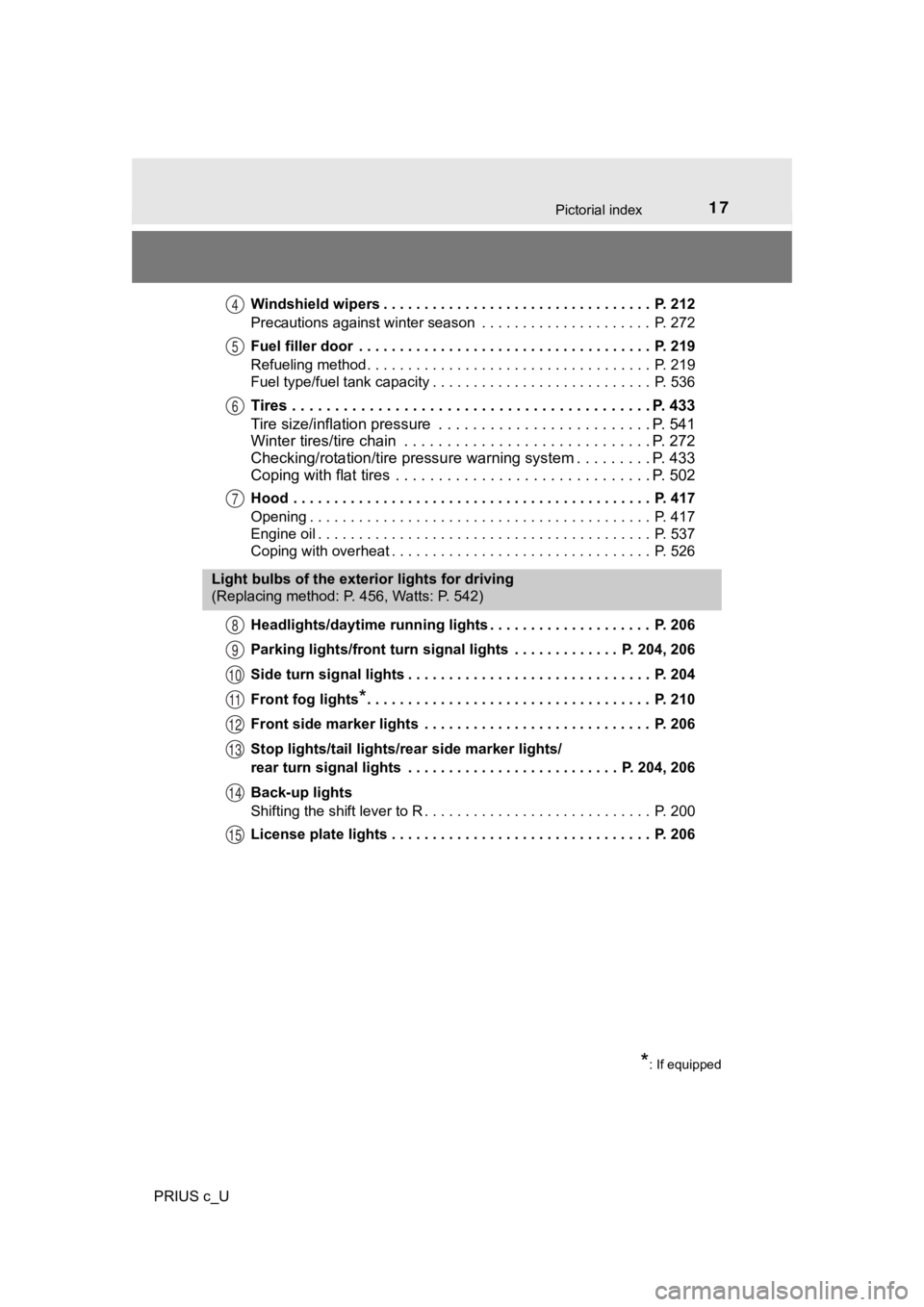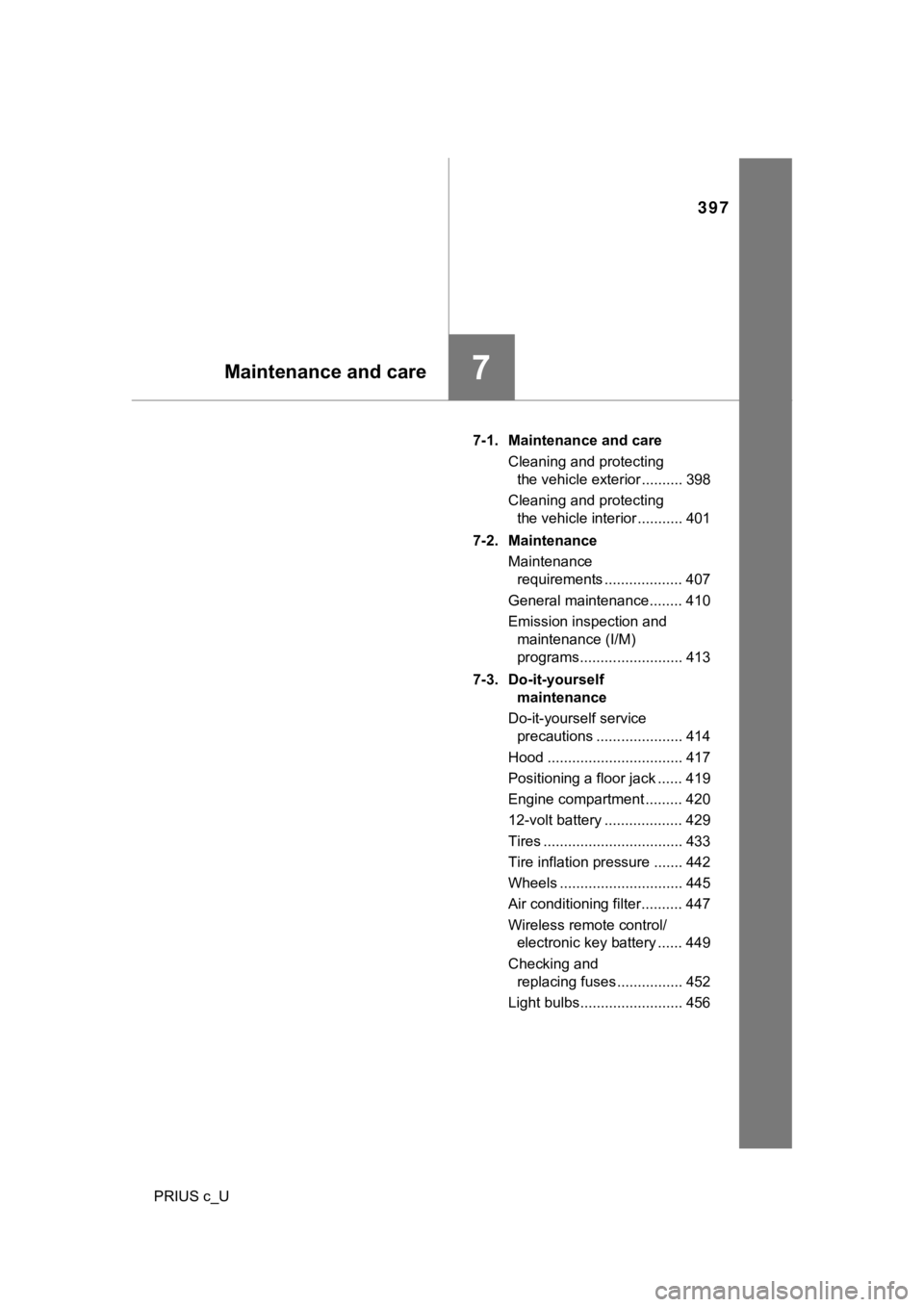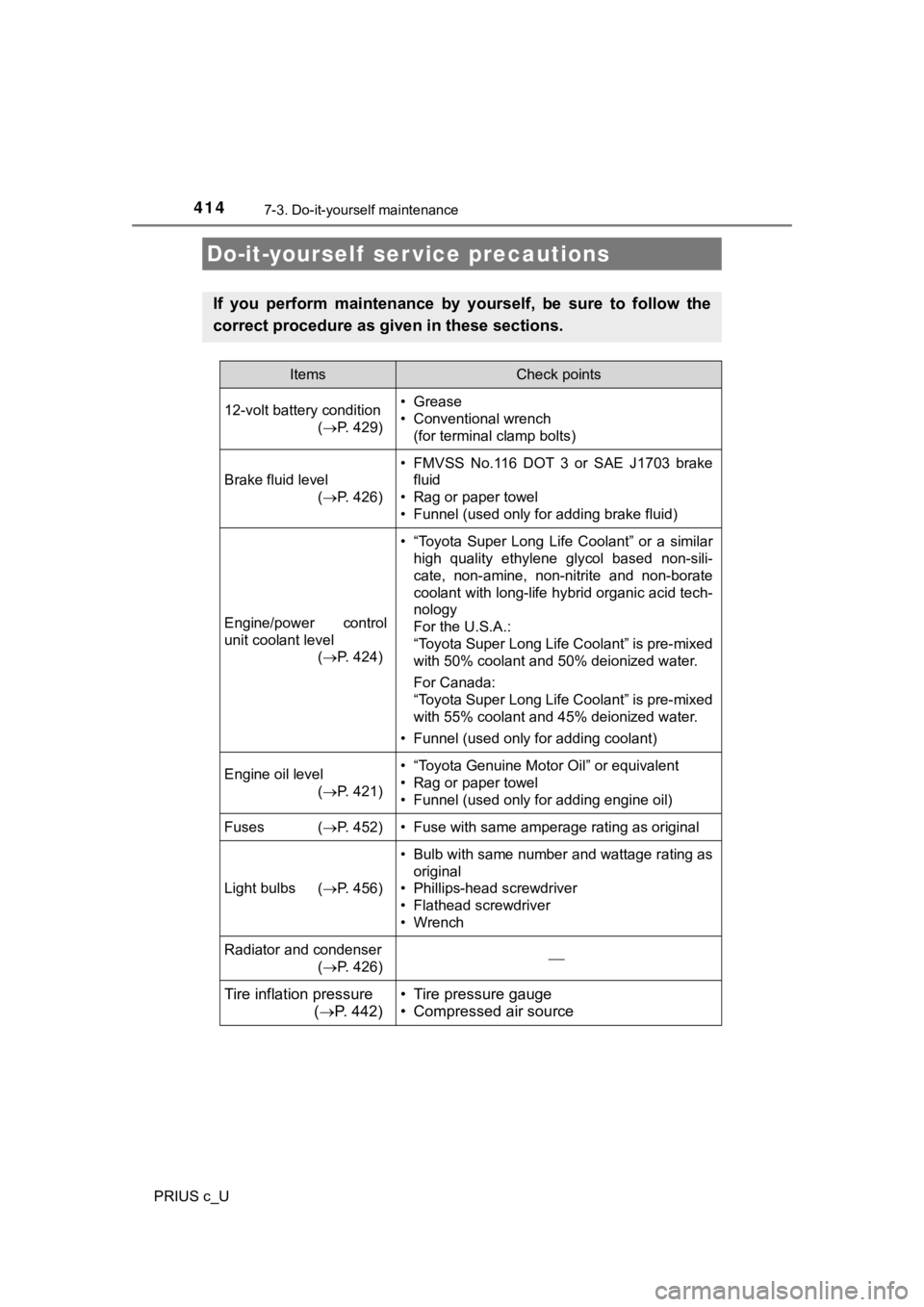check engine light TOYOTA PRIUS C 2019 Owners Manual (in English)
[x] Cancel search | Manufacturer: TOYOTA, Model Year: 2019, Model line: PRIUS C, Model: TOYOTA PRIUS C 2019Pages: 596, PDF Size: 10.42 MB
Page 6 of 596

TABLE OF CONTENTS6
PRIUS c_U7-1. Maintenance and care
Cleaning and protecting the vehicle exterior .......... 398
Cleaning and protecting the vehicle interior ........... 401
7-2. Maintenance Maintenance requirements ................... 407
General maintenance ........ 410
Emission inspection and maintenance (I/M)
programs ......................... 413
7-3. Do-it-yourself maintenance
Do-it-yourself service precautions ..................... 414
Hood.................................. 417
Positioning a floor jack ...... 419
Engine compartment ......... 420
12-volt battery ................... 429
Tires .................................. 433
Tire inflation pressure........ 442
Wheels .............................. 445
Air conditioning filter .......... 447
Wireless remote control/ electronic key battery ...... 449
Checking and replacing fuses ................ 452
Light bulbs ......................... 456 8-1. Essential information
Emergency flashers ........... 466
If your vehicle has to be stopped in
an emergency.................. 467
8-2. Steps to take in an emergency
If your vehicle needs to be towed ...................... 469
If you think something is wrong ........................... 476
If a warning light turns on or a warning buzzer
sounds ............................. 477
If a warning message is displayed...................... 485
If you have a flat tire .......... 502
If the hybrid system will not start ..................... 515
If the electronic key does not operate properly ........ 517
If the vehicle 12-volt battery is discharged ....... 519
If your vehicle overheats......................... 526
If the vehicle becomes stuck ................ 530
7Maintenance and care8When trouble arises
Page 17 of 596

17Pictorial index
PRIUS c_UWindshield wipers . . . . . . . . . . . . . . . . . . . . . . . . . . . . . . . . . P. 212
Precautions against winter season . . . . . . . . . . . . . . . . . . . . . P. 272
Fuel filler door . . . . . . . . . . . . . . . . . . . . . . . . . . . . . . . . . . . . P. 219
Refueling method . . . . . . . . . . . . . . . . . . . . . . . . . . . . . . . . . . . P. 219
Fuel type/fuel tank capacity . . . . . . . . . . . . . . . . . . . . . . . . . . . P. 536
Tires . . . . . . . . . . . . . . . . . . . . . . . . . . . . .
. . . . . . . . . . . . . P. 433
Tire size/inflation pressure . . . . . . . . . . . . . . . . . . . . . . . . . P. 541
Winter tires/tire chain . . . . . . . . . . . . . . . . . . . . . . . . . . . . . P. 272
Checking/rotation/tire pressur e warning system . . . . . . . . .P. 433
Coping with flat tires . . . . . . . . . . . . . . . . . . . . . . . . . . . . . . P. 502
Hood . . . . . . . . . . . . . . . . . . . . . . . . . . . . . . . . . . . . . . . . . . . . P. 417
Opening . . . . . . . . . . . . . . . . . . . . . . . . . . . . . . . . . . . . . . . . . . P. 417
Engine oil . . . . . . . . . . . . . . . . . . . . . . . . . . . . . . . . . . . . . . . . . P. 537
Coping with overheat . . . . . . . . . . . . . . . . . . . . . . . . . . . . . . . . P. 526
Headlights/daytime running lights . . . . . . . . . . . . . . . . . . . . P. 206
Parking lights/front turn signal lights . . . . . . . . . . . . . P. 204, 206
Side turn signal lights . . . . . . . . . . . . . . . . . . . . . . . . . . . . . . P. 204
Front fog lights
*. . . . . . . . . . . . . . . . . . . . . . . . . . . . . . . . . . . P. 210
Front side marker lights . . . . . . . . . . . . . . . . . . . . . . . . . . . . P. 206
Stop lights/tail lights /rear side marker lights/
rear turn signal lights . . . . . . . . . . . . . . . . . . . . . . . . . . P. 204, 206
Back-up lights
Shifting the shift lever to R . . . . . . . . . . . . . . . . . . . . . . . . . . . . P. 200
License plate lights . . . . . . . . . . . . . . . . . . . . . . . . . . . . . . . . P. 206
4
5
6
7
Light bulbs of the exterior lights for driving
(Replacing method: P. 456, Watts: P. 542)
*: If equipped
8
9
10
11
12
13
14
15
Page 174 of 596

1744-1. Before driving
PRIUS c_U
WARNING
Observe the following precautions.
Failure to do so may result in death or serious injury.
■When driving on slippery road surfaces
● Sudden braking, acceleration and steering may cause tire slippa ge and
reduce your ability to control the vehicle.
● Sudden acceleration, engine braking due to shifting, or changes in engine
speed could cause the vehicle to skid.
● After driving through a puddle, lightly depress the brake pedal to make
sure that the brakes are functioning properly. Wet brake pads m ay prevent
the brakes from functioning properly. If the brakes on only one side are wet
and not functioning properly, steering control may be affected.
■ When shifting the shift lever
● Do not let the vehicle roll backward while the shift lever is i n a driving posi-
tion, or roll forward while the shift lever is in R.
Doing so may result in an accident or damage to the vehicle.
● Do not shift the shift lever to P while the vehicle is moving.
Doing so can damage the transmission and may result in a loss o f vehicle
control.
● Do not shift the shift lever to R while the vehicle is moving f orward.
Doing so can damage the transmission and may result in a loss o f vehicle
control.
● Do not shift the shift lever to a driving position while the ve hicle is moving
backward.
Doing so can damage the transmission and may result in a loss o f vehicle
control.
● Shifting the shift lever to N while the vehicle is moving will disengage the
hybrid system. Engine braking is not available when N is select ed.
● Be careful not to shift the shift lever with the accelerator pe dal depressed.
Shifting the shift lever to any position other than P or N may lead to unex-
pected rapid acceleration of the vehicle that may cause an acci dent and
result in death or serious injury.
■ If you hear a squealing or scrap ing noise (brake pad wear limit indica-
tors)
Have the brake pads checked and replaced by your Toyota dealer as soon
as possible.
Rotor damage may result if the pads are not replaced when needed.
It is dangerous to drive the vehicle when the wear limits of the brake pads
and/or those of the brake discs are exceeded.
Page 186 of 596

186
PRIUS c_U
4-2. Driving procedures
Check that the parking brake is set.
Check that the shift lever is in P.
Firmly depress the brake pedal.
Turn the power switch to the
“START” position to start the
hybrid system.
If the “READY” indicator turns on,
the hybrid system will operate nor-
mally.
Continue depressing the brake
pedal until the “READY” indicator
is illuminated.
Check that the “R EADY” indicator is illuminated.
If the “READY” indicator changes from a flashing light to a sol id light and a
beep sound, the hybrid system is starting normally.
The vehicle will not move when the “READY” indicator is off.
The vehicle can move when the “READY” indicator is on even if t he engine
is stopped. (The engine starts or stops automatically in accord ance with
the state of the vehicle.)
Power (ignition) switch (vehicles without a
smart key system)
Starting the hybrid system
1
2
3
4
5
Page 191 of 596

1914-2. Driving procedures
4
Driving
PRIUS c_U
Check that the “READY” indicator is illuminated.
If the “READY” indicator changes from a flashing light to a sol id light and a
beep sound, the hybrid system is starting normally.
The vehicle will not move when the “READY” indicator is off.
The vehicle can move when the “READY” indicator is on even if t he engine
is stopped. (The engine starts or stops automatically in accord ance with
the state of the vehicle.)
Stop the vehicl e completely.
Set the parking brake ( P. 205), and shift the shift lever to P.
Press the power switch.
Release the brake pedal and c heck that on the multi-infor-
mation display is off.
Modes can be changed by pressing the power switch with brake pe dal
released. (The mode changes each time the switch is pressed.)
Off
*
The emergency flashers can be
used.
ACCESSORY mode
Some electrical components such
as the power outlet can be used.
will be displayed on the
multi-information display.
ON mode
All electrical components can be
used.
will be displayed on the
multi-information display.
*: If the shift lever is in a position other than P when turning off the hybrid sys-
tem, the power switch will be turned to ACCESSORY mode, not to off.
Stopping the hybrid system
Changing power switch modes
5
1
2
3
4
1
2
3
Page 270 of 596

2704-7. Driving tips
PRIUS c_U
◆Delays
Repeated acceleration and deceleration, as well as long waits at
traffic lights, will lead to bad fuel economy. Check traffic re ports
before leaving and avoid delays as much as possible. When drivi ng
in a traffic jam, gently release the brake pedal to allow the v ehicle to
move forward slightly while avoid ing overuse of the accelerator
pedal. Doing so can help control excessive gasoline consumption.
◆Highway driving
Control and maintain the vehicle at a constant speed. Before st op-
ping at a toll booth or similar, allow plenty of time to releas e the
accelerator and gently apply the brakes. A greater amount of el ec-
trical energy can be regenerated when slowing down.
◆Air conditioning
Use the air conditioning only when necessary. Doing so can help
reduce excessive gasoline consumption.
In summer: When the ambient tempe rature is high, use the recircu-
lated air mode. Doing so will help to reduce the burden on the air
conditioning system and reduce fuel consumption as well.
In winter: Because the gasolin e engine will not automatically cut out
until it and the interior of the vehicle are warm, it will cons ume fuel.
Also, fuel consumption can be improved by avoiding overuse of t he
heater.
◆Checking tire inflation pressure
Make sure to check the tire inflation pressure frequently. Impr oper
tire inflation pressure can cause poor fuel economy.
Also, as snow tires can cause large amounts of friction, their use on
dry roads can lead to poor fuel economy. Use tires that are app ro-
priate for the season.
◆Luggage
Carrying heavy luggage will lead to poor fuel economy. Avoid carry-
ing unnecessary luggage. Installing a large roof rack will also cause
poor fuel economy.
Page 272 of 596

2724-7. Driving tips
PRIUS c_U
●Use fluids that are appropriate t o the prevailing outside tempera-
tures. • Engine oil
• Engine/power control unit coolant
• Washer fluid
● Have a service technician inspect the condition of the 12-volt bat-
tery.
● Have the vehicle fitted with four snow tires or purchase a set of tire
chains for the front tires.
Ensure that all tires are the same size and brand, and that cha ins match
the size of the tires.
Perform the following according to the driving conditions:
● Do not try to forcibly open a window or move a wiper that is fr ozen.
Pour warm water over the frozen area to melt the ice. Wipe away
the water immediately to p revent it from freezing.
● To ensure proper operation of the climate control system fan,
remove any snow that has accumulated on the air inlet vents in
front of the windshield.
● Check for and remove any excess ic e or snow that may have accu-
mulated on the exterior lights, vehicle's roof, chassis, around the
tires or on the brakes.
● Remove any snow or mud from the bottom of your shoes before
getting in the vehicle.
Accelerate the vehicle slowly, keep a safe distance between you and
the vehicle ahead, and drive at a reduced speed suitable to roa d con-
ditions.
Winter driving tips
Carry out the necessary preparations and inspections before
driving the vehicle in winter. Always drive the vehicle in a ma n-
ner appropriate to the prevailing weather conditions.
Pre-winter preparations
Before driving the vehicle
When driving the vehicle
Page 397 of 596

397
7Maintenance and care
PRIUS c_U7-1. Maintenance and care
Cleaning and protecting the vehicle exterior .......... 398
Cleaning and protecting the vehicle interior ........... 401
7-2. Maintenance Maintenance requirements ................... 407
General maintenance........ 410
Emission inspection and maintenance (I/M)
programs......................... 413
7-3. D o-it-yourself
m aintenance
Do-it-yourself service precautions ..................... 414
Hood ................................. 417
Positioning a floor jack ...... 419
Engine compartment ......... 420
12-volt battery ................... 429
Tires .................................. 433
Tire inflation pressure ....... 442
Wheels .............................. 445
Air conditioning filter.......... 447
Wireless remote control/ electronic key battery ...... 449
Checking and replacing fuses ................ 452
Light bulbs......................... 456
Page 414 of 596

414
PRIUS c_U
7-3. Do-it-yourself maintenance
Do-it-yourself ser vice precautions
If you perform maintenance by yourself, be sure to follow the
correct procedure as given in these sections.
ItemsCheck points
12-volt battery condition (
P. 429) •
Grease
• C onventional wrench
(for te rminal clamp bolts)
Brake fluid level
(P. 426)
• FMVSS No.116 DOT 3 or SAE J1703 brake
fluid
• Rag or paper towel
• Funnel (used only for adding brake fluid)
Engine/power control
unit coolant level (P. 424)
• “Toyota Super Long Life Coolant” or a similar
high quality ethylene glycol based non-sili-
cate, non-amine, non-nitrite and non-borate
coolant with long-life hybrid organic acid tech-
nology
For the U. S.A.:
“Toyota Super Long Life Coolant” is pre-mixed
with 50% coolant and 50% deionized water.
For Canada:
“Toyota Super Long Life Coolant” is pre-mixed
with 55% coolant and 45% deionized water.
• Funnel (used only for adding coolant)
Engine oil level (P. 421)• “Toyota Genuine Motor Oil” or equivalent
• Rag or paper towel
• Funnel (used only for adding engine oil)
Fuses ( P. 452)• Fuse with same amperage rating as original
Light bulbs (P. 456)
• Bulb with same number and wattage rating as
original
• Phillips-head screwdriver
• Flathead screwdriver
• Wrench
Radiator and condenser
(P. 426)
Tire inflation pressure
( P. 442)• Tire pressure gauge
• Compressed air source
Page 588 of 596

588Alphabetical index
PRIUS c_U
Eco drive mode ........................ 201
Electric power steering ........... 263
Electronic keyIf the electronic key does not operate properly ........... 517
Emergency flashers Switch ................................... 466
Emergency, in case of
If a warning buzzer sounds ........................ 477, 485
If a warning light
turns on .............................. 477
If a warning message is displayed ............................ 485
If the electronic key does not operate properly ........... 517
If the hybrid system will
not start .............................. 515
If the vehicle becomes stuck ................................... 530
If the vehicle 12-volt battery is discharged .......... 519
If you have a flat tire ............ 502
If you lose your keys ............. 120
If you think something is
wrong.................................. 476
If your vehicle has to
be stopped in an
emergency.......................... 467
If your vehicle needs to
be towed ............................. 469
If your vehicle overheats ....... 526 Engine
Compartment ........................ 420
Hood ..................................... 417
How to start the hybrid system ....... ................. 186, 190
Identification number ............ 535
If the hybrid system will not start .............................. 515
Ignition switch ............... 186, 190
Overheating .......................... 526
Power switch ................ 186, 190
Engine coolant Capacity................................ 538
Checking............................... 424
Preparing and checking before winter ...................... 272
Engine oil
Capacity................................ 537
Checking............................... 421
Preparing and checking before winter ...................... 272
Engine/power control unit coolant
Capacity................................ 538
Checking............................... 424
Preparing and checking before winter ...................... 272
EPS ........................................... 263
EV drive mode ......................... 197
Event data recorder................... 11
Exclusive jump starting terminal .................... 519
E